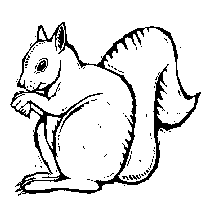


Tree trimming is a subject near and dear to our hearts here at Wildlife Rescue, because each year we receive a significant number of baby squirrels and birds who have been injured or orphaned by tree trimmings. Most of our "guests" come to us in the spring, which is the worst time to prune a tree-for both the tree and the wildlife living in it. Surprisingly, few people know that. So, to help educate our friends and supporters about proper tree trimming practices, we've put together this brief informational sheet. We hope you find it useful-and, of course, we also hope it helps reduce the number of baby squirrels and birds injured, orphaned, and killed by tree trimming.
Once upon a time arborists believed the best way to maintain a tree was to cut out about a third of its interior branches every few years, ostensibly to let light into the canopy and to "tidy up" the tree. But then research in tree care showed that pruning can actually harm trees. Not only does does it traumatize them, causing them to expend a great deal of energy to recover, but it also makes them highly susceptible to disease. For these reasons, tree care researchers now say that the best pruning is none at all. According to a September 1994 article in House Beautiful magazine, arborists recommend that you prune only to remove dead or diseased wood or branches that may injure the tree by chafing against each other. For aesthetics, you may also cut any branches that cross the center of the tree, but otherwise, just leave the tree the way Mother Nature intended it to be.
If you absolutely have to prune a tree, be sure to check the area for squirrel or bird nests first. Squirrels nest twice a year-from February to May, then again from July to September-and their nests look like a big clot of leaves and twigs caught in the crotch of two branches (either near the trunk or farther out on the limb). Bird nests are smaller and harder to find, especially hummingbird nests, so just look for a dark spot tucked among the smaller branches. If you find a nest filled with eggs or babies, leave it alone. Moving a nest can severely hurt the babies' chance of survival-and it may even be against the law. Under the Migratory Bird Treaty Act, it's illegal to harm or remove the nests of all migratory and native birds, and most songbirds. So to be absolutely safe, put off pruning until the babies have flown the coop.
Keep in mind that some seasons are better for pruning than others. For the rest of the United States where there are four bona fide seasons, arborists recommend pruning in the winter (when trees have the greatest reserves of energy stored in their tissues and can cope with the shock of pruning) or in the fall, just after deciduous trees have lost their leaves. In California, however, most trees don't lose their leaves until December, so that's the best time to prune-for trees and for wildlife. By then, squirrel and bird babies have reached self-sufficiency and their parents have wrapped up their procreation activities for the year. The worst time to prune a tree is in the spring. That's the height of the nesting season for most birds and squirrels, and it's also the time when a tree is directing all of its energy into producing new growth. Pruning in the springtime can not only impede a tree's growth, but also increase its chances of becoming diseased.
As always, there are exceptions to the rule: dead wood can be removed anytime of the year, and weak shoots that sprout out of existing limbs or old wounds should be pruned in the late summer, after the tree has finished its growth spurt. Just be sure to check the area for nests before you cut. And for the sake of your trees and the wildlife living in them, don't cover the stubs of just-cut limbs with those black wound-dressings. Birds can foul their feathers by brushing up against the goo, and the dressings can make your tree vulnerable to widespread damage by covering up early signs of bacterial infection. Just make a clean cut and leave it at that. Your trees-and your wildlife-will be healthier for it.
For more information about tree trimming, or about Wildlife Rescue, please call the shelter at (650)494-SAVE.
